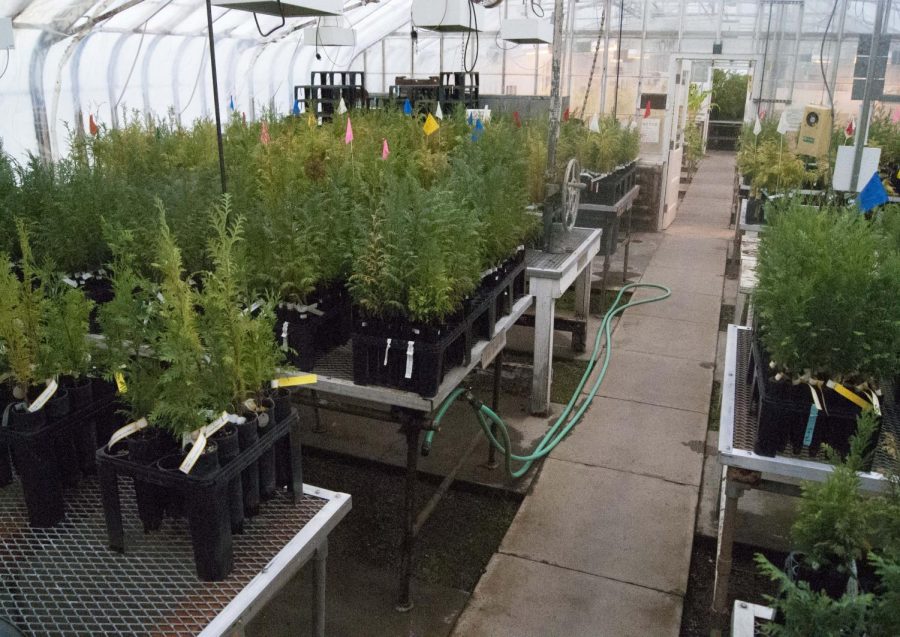Campus greenhouse able to grow almost any crop in Oregon
May 20, 2019
The East Greenhouse at Oregon State University built in 1928, tucked between Withycombe Hall and Cordley Hall, is made up of 19 separate greenhouse rooms and holds space for teaching, as well a variety of ongoing research projects.
The Greenhouse is used by College of Agricultural Sciences and the Agricultural Experiment Station staff and students from the botany and horticulture departments for teaching and research purposes, according to Jim Ervin, the manager of the OSU east and west greenhouses.
“The teaching greenhouse space for both botany and horticulture takes up about 40 percent of the greenhouse space,” Ervin said. “The rest are used for research purposes and there are a variety of projects going on.”
Ervin added, what makes the OSU greenhouses so unique is the fact that it is a research and teaching facility. The greenhouse facility has the ability to grow almost any commodity plant that grows in Oregon at any given time. This can range from fruits to grains to trees.
“We have wheat, barley, hazelnuts, strawberries, tomatoes, corn the list goes on,” Ervin said. “Douglas Fir trees, Cedar trees, potatoes, all kinds of plant material that you normally wouldn’t think would be growing in a greenhouse.”
Zuzana Vejlupkova is a senior faculty research assistant in Dr. John Fowler’s lab for the Department of Botany and Plant Pathology. According to Vejlupkova the research focus of the group she works with is cell & molecular biology and plant genetics. The team is most interested in genes involved in male gametophyte (pollen) development and function. Members of Dr. Fowler’s team are using corn as a model organism. Besides growing corn in the field, they are using the greenhouse to grow plants year round.
“Our studies involve pollen and controlled pollinations to produce next generations. This allows us to study mutations in genes involved in pollen function and development,” Vejlupkova said. “We are using fresh pollen and other plant tissues year round. Corn does not grow outside in the winter in the Pacific North West, therefore we use the greenhouse.”
According to Vejlupkova all the plant care, soil movement, sample collections and crossing is done by members of the research group, which includes undergraduate student workers. Vejlupkova added the greenhouse crew usually water their plants and monitor for pests. The greenhouse crew has also assisted the lab with ordering, testing, repairing and installing growth lights.
Ervin, the greenhouse manager said, there are three full time technicians that do various tasks within the greenhouse, a student crew that does the majority of the manual labor and there are three students that live on sight that tend to the greenhouses after regular hours and weekends 365 days per year. Kristina Ribeiro is a second year student studying agriculture science and is one of the residents living in the greenhouse apartment.
“My role is to unlock and lock up, record temperatures in the greenhouses, water plants, and do other maintenance tasks every once in a while,” Ribeiro said. “After office hours there is a resident work phone we carry, so if anything goes wrong, the phone gets called and we have to take care of it. Other than that we live on sight and it’s pretty much the same as any other apartment.”
Tyler Hoskins, a faculty research assistant for the department of horticulture, uses the East Greenhouse to teach HORT311, an undergraduate course in plant propagation, as well as propagating plants for the ornamental breeding program.
“HORT311 is a core class for Hort majors. Lab sessions of the course are held in the greenhouses and we teach basic principles and practices of propagating a variety of horticultural crops,” Hoskins said. “These are skills that are transferable to a range of horticultural disciplines and can be used on farms and nurseries.”
Hoskins added, when class is in session the students grow a variety of ornamental trees and shrubs, fruit and vegetable crops and grafted fruit trees, in the greenhouse. During the year when class is not in session the crew breed plants from their parent stock for the breeding program.
“We also propagate plants for our breeding program when class is not in session. This involves rooting cuttings of a wide range of landscape tree and shrub varieties,” Hoskins said.
According to Hoskins, in the sector of the greenhouse he is apart of, because of the breeding program, everything they grow is new and does not yet exist on the market.
“It’s too long a list to give, but there are new varieties of trees and shrubs that may eventually be released for use in the nursery industry.”


















































































![Newspaper clipping from February 25, 1970 in the Daily Barometer showing an article written by Bob Allen, past Barometer Editor. This article was written to spotlight both the student body’s lack of participation with student government at the time in conjunction with their class representatives response. [It’s important to note ASOSU was not structured identically to today’s standards, likely having a president on behalf of each class work together as one entity as opposed to one president representing all classes.]](https://dailybaro.orangemedianetwork.com/wp-content/uploads/2025/03/Screenshot-2025-03-12-1.00.42-PM-e1741811160853.png)
























